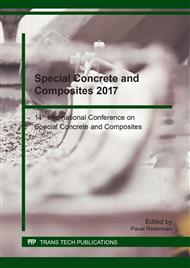[1]
V. Nežerka, J. Němeček, Z. Sližkova, P. Tesárek, Investigation of crushed brick-matrix interface in lime-based ancient mortar by microscopy and nanoindentation, Cement & Concrete Composites 55 (2015) 122–128.
DOI: 10.1016/j.cemconcomp.2014.07.023
Google Scholar
[2]
J. Němeček, Mikromechanické vlastnosti cementových kompozitů, Diplomová práce, ČVUT Praha, (01/2017).
Google Scholar
[3]
J. Němeček, V. Králík, V. Šmilauer, L. Polívka, A. Jäger, Tensile strength of hydrated cement paste phases assessed by micro-bending tests and nanoindentation, Cement and Concrete Composites 73 (2016) 164-173.
DOI: 10.1016/j.cemconcomp.2016.07.010
Google Scholar
[4]
J. Němeček, V. Kralík, J. Vondřejc, Micromechanical analysis of heterogeneous structural materials, Cement & Concrete Composites 36 (2013) 85–92.
DOI: 10.1016/j.cemconcomp.2012.06.015
Google Scholar
[5]
S. Diamond, J. Huang, The ITZ in concrete – a different view based on image analysis and SEM observations, Cement and Concrete Composites 23 (2001) 179-188.
DOI: 10.1016/s0958-9465(00)00065-2
Google Scholar
[6]
V. Petráňová, T. Sajdlová, J. Němeček, Micromechanical Homogenization of Ultra-High Performance Concrete, Applied Mechanics and Materials Vol. 821 (2016) 518-525.
DOI: 10.4028/www.scientific.net/amm.821.518
Google Scholar
[7]
K. L. Scrivener, A. K. Crumbie, P. Laugesen, The Interfacial Transition Zone (ITZ) Between Cement Paste and Aggregate in Concrete, Interface Science 12 (2004) 411–421.
DOI: 10.1023/b:ints.0000042339.92990.4c
Google Scholar
[8]
P. Vargas, O. Restrepo-Baena, J. I. Tobón, Microstructural analysis of interfacial transition zone (ITZ) and its impact on the compressive strength of lightweight concretes, Construction and Building Materials 137 (2017) 381–389.
DOI: 10.1016/j.conbuildmat.2017.01.101
Google Scholar
[9]
P.G. Allison, R.D. Moser, C.A. Weiss Jr., P.G. Malone, S.W. Morefield, Nanomechanical and chemical characterization of the interface between concrete, glass–ceramic bonding enamel and reinforcing steel, Construction and Building Materials 37 (2012).
DOI: 10.1016/j.conbuildmat.2012.07.066
Google Scholar
[10]
W. Zhu, Peter J.M. Bartos, Application of depth-sensing microindentation testing to study of interfacial transition zone in reinforced concrete, Cement and Concrete Research 30 (2000) 1299-1304.
DOI: 10.1016/s0008-8846(00)00322-7
Google Scholar
[11]
X. H. Wang, S. Jacobsen, J. Y. He, Z. L. Zhang, S. F. Lee, H. L. Lein, Application of nanoindentation testing to study of the interfacial transition zone in steel fiber reinforced mortar, Cement and Concrete Research 39 (2009) 701–715.
DOI: 10.1016/j.cemconres.2009.05.002
Google Scholar
[12]
Zhang J., Sun H., Wan J., Yi Z., Study on microstructure and mechanical property of interfacial transition zone between limestone aggregate and Sialite paste, Construction and Building Materials 23 (2009) 3393–3397.
DOI: 10.1016/j.conbuildmat.2009.06.037
Google Scholar
[13]
W.C. Oliver, G.M. Pharr, An improved technique for determining hardness and elastic modulus using load and displacement sensing indentation experiments, J. Mat. Res. 7 (1992) 1564-1583.
DOI: 10.1557/jmr.1992.1564
Google Scholar


